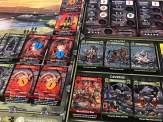| Release Date: 2016 | Players: 2-4 |
| Designer: Asger Harding Granerud | Length: 30-45 minutes |
| Artist: Jere Kasanen, Ossi Hiekkala | Age: 8+ |
| Publisher: Lautapelit.fi | Complexity: 1.5 / 5 |
| Plastic (by weight): unknown | Air (by volume): unknown |
We had started in Florence when everyone was still fresh and raring to go. An endless sea of bicycles with teams sticking closely together had lined up at the starting line. The support teams had only done their last checks minutes before and everything was shiny and gleaming. Now, several thousand kilometres later, everyone started to show signs of slowing down. Yet, at the horizon a welcome sign became visible. We knew it wasn’t going to be much further. There it was, the red flag, the Flamme Rouge by Asger Harding Granerud from Lautapelit.fi.
Listen to the Audio Version
Intro Music: Bomber (Sting) by Riot (https://www.
Sound Effects: bbc.co.uk – © copyright 2024 BBC
Overdrive (By PraxI) by Diamond Ace | https://soundcloud.
Music promoted by https://www.
Creative Commons / Attribution-ShareAlike 3.0 Unported (CC BY-SA 3.0)
https://creativecommons.
With the Tour de France heading towards its conclusion, it’s only fitting I finally review this classic bicycle racing game. The game is from the same designer who would bring out the car-racing sibling Heat: Pedal to the Metal six years later. While many people prefer the tyre-burning game over the endurance race that is Flamme Rouge, I think I prefer the leisurely pace and simplicity of the original bicycle game.
Let me go back to the starting line in Florence and tell you a bit more about how the game works.
Rolling and Sprinting
At its core, Flamme Rouge is a hand management game. Players all have the same two decks of cards. Each deck controls one of the two riders, the Rouleur and the Sprinteur. As the names suggest, the Rouleur has stamina, but not necessarily speed, while the Sprinteur can race ahead when it counts. So far, so easy.
In fact, it doesn’t get much trickier. Every round, players draw the top four cards from one of the riders’ decks, choose one, put that card face-down in front of them and put the others face-up underneath that rider’s deck. Players then do the same with the other rider. It’s your choice which rider you want to select the card for first.
Once everyone is ready, all cards are revealed. Then the frontmost rider goes first and moves forward the number of spaces that is indicated on their relevant card. Then the next rider goes until everyone has taken their turn. So far, still so simple.
The track is modular and chosen from one of the many options provided by the game – or you could make up your own, if you wanted to. The track is also divided into equal lengths, representing the number of steps riders move forward. Each length is further divided into spaces that each can hold one rider. While some parts of the track are wide enough to hold three cyclists, most of the track only has room for two and there are even areas that only have space for one.
If a rider lands on the same section as another rider, they take up one of the available spaces alongside them. If there are no spaces left, they move back one section, and if that is full as well, they keep going back until there is room.

Counting Cards
So it is possible that you play a high card, but only get to move forward a handful of spaces, if you are towards the back of the field and there is a bunching up of riders in front of you. That’s a huge waste of a good card, which is a problem, because every card you play gets removed and is out of the game completely. It never comes back. So you need to try and plan ahead and gauge what other players might be doing.
Once all riders have taken their turn, there is the possibility of slip-streaming. Any group of riders that has a gap of a single space to the group in front, moves forward one space to catch up. That is a really clever mechanism in Flamme Rouge. If you get it right, you can use a lower-value card but still stay with the group.
In fact, groups of riders are an important concept in the game, because after slip-streaming, the leader or leaders of every group that is still separate get a penalty card, which is a movement of only two spaces, added to their discard pile of cards that were previously not chosen at the beginning of the round. So if you can stay in the middle of a group, you’ll be all right.
Saying that, the decks of cards aren’t actually enough for riders to get to the end of the track and across the finish line. So ultimately you do need to get these penalty cards and you want to play them at the right time to avoid slowing to a crawl near the end.
So having a good handle on your decks of cards is important. If you can card count, you should do well.
Shuffled Luck
Of course, like in many of these types of games, there is a good element of luck. Knowing what cards are left in your decks is one thing, but drawing the right card at the right time from the shuffled decks is another. It’s always hilarious when you think you have the perfect opportunity to break away from the peloton and cross the finish line first, but you only draw low-value cards. The muffled cursing that ensues is not unexpected and will be a common occurrence when you play Flamme Rouge.
Even trying to gauge what other players are doing is affected by the luck of the card draw. You might be almost 100% certain that another player will move a certain number of spaces ahead. So you play a card to stay right behind them and maybe even slip-stream forward. While the other player may well have planned to do exactly what you thought, if they don’t get the right cards, you might shoot right past them and end up with a penalty card at the wrong time in the game.
Yet, there isn’t complete chaos in Flamme Rouge. It’s predictable enough to allow you to make meaningful choices and have a fair amount of influence on what happens on the track. In fact, because you have two riders, chances are that at least one of them will allow you to make the best of the other rider’s bad card draw.

K2, But Quicker
What is really amazing is how much the game really immerses you in the theme. It’s not only because of the plastic bikes with their little riders on, but also the illustrations of the track. As you play cards, you start to feel like you’re actually pedalling yourself. As the race gets closer to the finish line, you rue your earlier decision to play a high-value card. You can feel how the riders lose energy and slow down. So whether you think of each game as a stage in the Tour de France or a shorter timed race, it’s always exciting and tight until the end.
The only other game that gave me the same sort of immersion is K2. In this mountain-climbing game, you feel the air getting thinner and the temperatures dropping. Yet, while K2 is a real endurance of a game that lasts a good hour and maybe more, Flamme Rouge is more of a short burst of energy, that makes you feel sweaty and exhausted in half the time.
I do love both games, but for different reasons. If I want an excruciating experience where we dice with death and where you can feel the frostbite setting in, then K2 is the perfect choice. However, if I want a high-energy experience in beautiful sunshine going up and down hills past cheering crowds that is over relatively quickly, then Flamme Rouge offers the same type of gameplay. So, yes, I would happily own both games and get them out equally often. What you choose will depend on what you’re after. I can only suggest you put on your lycra and get on your bike to see how it feels.
Keeping the blog running takes time and resources. So if you can chip in, that would be amazing.
Useful Links
- Flamme Rouge: https://en.
lautapelit. fi/ product/ 22825/ flamme-rouge-eng - Rulebook: https://boardgamegeek.
com/ filepage/ 132037/ rulebook - Lautapelit.fi: https://en.
lautapelit. fi/ - BGG listing: https://boardgamegeek.
com/ boardgame/ 199478/ flamme-rouge - K2 review: https://tabletopgamesblog.
com/ 2021/ 09/ 25/ k2-digital-eyes/
Videos
Transparency Facts
I feel that this review reflects my own, independent and honest opinion, but the facts below allow you to decide whether you think that I was influenced in any way. Please also read my Ethics Statement for more information.- I played a friend's copy of the game.
- At the time of writing, I have not received financial support from the publisher or anyone working on their behalf.
Audio Version
Intro Music: Bomber (Sting) by Riot (https://www.
Sound Effects: bbc.co.uk – © copyright 2024 BBC
Overdrive (By PraxI) by Diamond Ace | https://soundcloud.
Music promoted by https://www.
Creative Commons / Attribution-ShareAlike 3.0 Unported (CC BY-SA 3.0)
https://creativecommons.
Playlist
These are the songs I listened to while I was writing this review:






